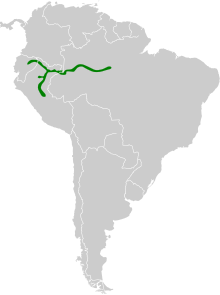Olive-spotted hummingbird
| Olive-spotted hummingbird | |
|---|---|

| |
| Scientific classification | |
| Kingdom: | Animalia |
| Phylum: | Chordata |
| Class: | Aves |
| Order: | Apodiformes |
| Family: | Trochilidae |
| Genus: | Talaphorus Mulsant & Verreaux, 1874 |
| Species: | T. chlorocercus
|
| Binomial name | |
| Talaphorus chlorocercus (Gould, 1866)
| |

| |
The olive-spotted hummingbird (Talaphorus chlorocercus) is a species of hummingbird in the family Trochilidae. It is the only species placed in the genus Talaphorus. It is found in western Brazil, Ecuador, Peru and far southeastern Colombia.
Its natural habitat is subtropical or tropical moist shrubland.
This hummingbird was previously placed in the genus Leucippus. A molecular phylogenetic study published in 2014 found that Leucippus was polyphyletic. To avoid the polyphyly the olive-spotted hummingbird was moved to the resurrected genus Talaphorus.[2][3][4]
Description[]
The olive-spotted hummingbird is 8 cm (3.1 in) in length, dull metallic green above, crown slightly browner, with a white postocular spot. It is whitish below, throat with a few olive spots, sides washed greenish. Tail green with grayish tips on outer feathers.[5]
References[]
- ^ BirdLife International (2012). "Leucippus chlorocercus". IUCN Red List of Threatened Species. 2012. Retrieved 26 November 2013.
- ^ McGuire, J.; Witt, C.; Remsen, J.V.; Corl, A.; Rabosky, D.; Altshuler, D.; Dudley, R. (2014). "Molecular phylogenetics and the diversification of hummingbirds". Current Biology. 24 (8): 910–916. doi:10.1016/j.cub.2014.03.016. PMID 24704078.
- ^ Stiles, F.G.; Remsen, J.V. Jr.; Mcguire, J.A. (2017). "The generic classification of the Trochilini (Aves: Trochilidae): Reconciling taxonomy with phylogeny". Zootaxa. 4353 (3): 401–424. doi:10.11646/zootaxa.4353.3. PMID 29245495.
- ^ Gill, Frank; Donsker, David; Rasmussen, Pamela, eds. (July 2020). "Hummingbirds". IOC World Bird List Version 10.2. International Ornithologists' Union. Retrieved 6 January 2020.
- ^ Ridgely, Robert and Paul Greenfield. The Birds of Ecuador. Volume II: Field Guide. Cornell, 2001
- IUCN Red List least concern species
- Trochilinae
- Birds of the Amazon Basin
- Birds of the Ecuadorian Amazon
- Birds of the Peruvian Amazon
- Birds described in 1866
- Hummingbird stubs
